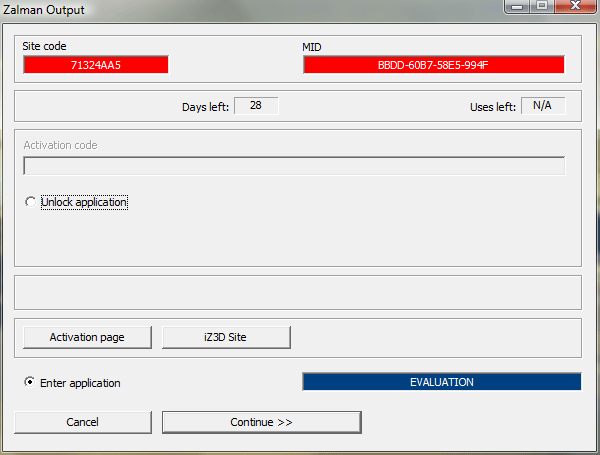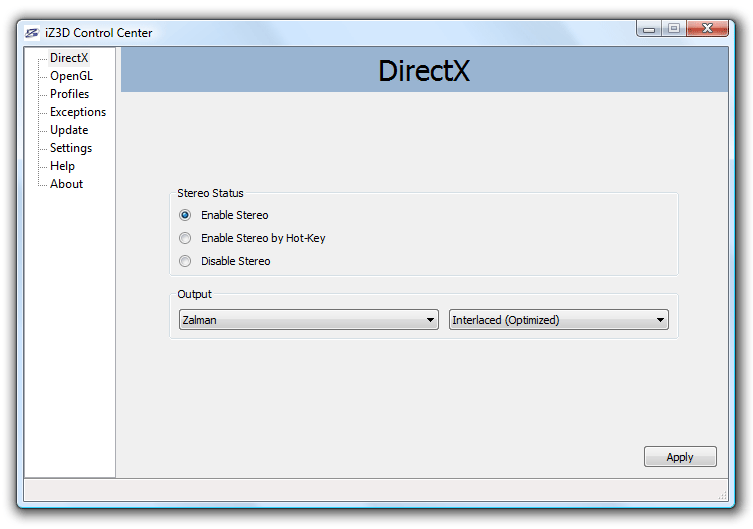Software support and games
Games wise things are ... well its not complicated but more annoying as there are so many variables and you do need to make a choice as to what software is going to drive your 3D Stereoscopic support.
In theory NVIDIA 3D stereoscopic software supports your polarized glasses/screen. But the suite is really targeted at active, and not passive stereoscopy. But if you have an NVIDIA GeForce graphics card, the free to use stereoscopic software is you best bet alright.

ATI Radeon users then. Well, the included software you'll get is from iZ3D. It is an older version and we did not hit update as it is merely trial software usable for 30 days, purchasing the driver will cost you 40 USD.

To get the monitor supported in proper 3D mode Zalman includes the iZ3D software suite. You'll often need to update this software to get your games supported. We used a slightly older suite and tried out a hand full of older games like Call of Duty Modern Warfare 2.
In the suite you simply select your monitor and mode, and then before each game starts a wizard will pop up. You start the game to a point where you have 3D objects and then with the help of shift +/- keys ect fine tune the desired stereoscopic effect.
The first impression, pretty nice. Polarized screens work well because no active LCD shutter glasses are strobing the light that gets to the eye, it is actually a very comfortable to watch method of stereoscopic 3D. Each eye only sees one of the images, and the effect is achieved.
Once calibrated we have to admit, this method does work out well, I did not expect it to be this good. The nature of the screen again is that while it is 1920x1080 you'll be looking at 1920x540 pixels. If you sit close to the screen you indeed can spot a tiny gap in-between the horizontal lines. But sit 50 CM away from the screen and it becomes a non-issue.
Game performance. We took a mid-range GeForce GTX 460 only and with COD MW2 at 1920x1080 we have a performance of 100 FPS on a Phenom II 955BE based system. So let's assume that is 100% and an easy number to work with. Now with active shutter glasses each eye will get an alternating frame, pretty much that can cut your framerate in half to 1.5x of your performance. The Polarization method has a much less significant performance hit. We measured roughly 85 frames per second with 3D enabled. So that's a 15% performance loss only.
With polarized stereoscopy we did spot crosstalk. If there is a dark scene and a bright object, some light on the edge of the bright object might be seen with the wrong eye. The generic rule however is that if that doesn't bother you in a theater chances are that it probably won't bother you behind that desktop PC. Also if you tilt your head or move it in an angle the more crosstalk you will see. So you need to be in a fairly static position to the screen.
Overall a lot of games are supported and work out pretty well. Constant annoyance is the calibration though. Once setup the experience is downright excellent, you really get a feel of depth, and the sensation is very very good. The 3D experience is hard to explain really, very immersive. It certainly did not disappoint.
And keep this in mind, though you forfeit on screen resolution (horizontal lines) your graphics card is much less stressed compared to active shutter glasses where each eye gets an alternating frame assigned, and since these need to double (60 Hz per eye preferably) that can cost you half the rendering performance of your graphics cards. So the performance hit is much less with passive stereoscopy. But sure, you are forfeiting on the horizontal lines, but that did not bother me greatly really.
